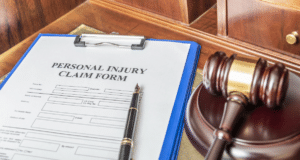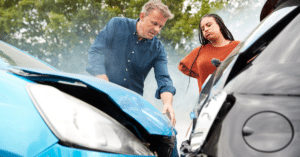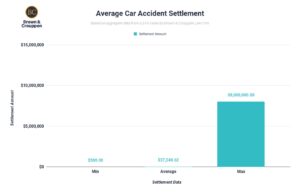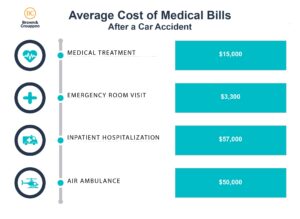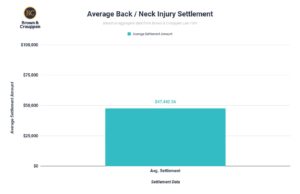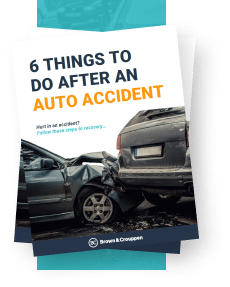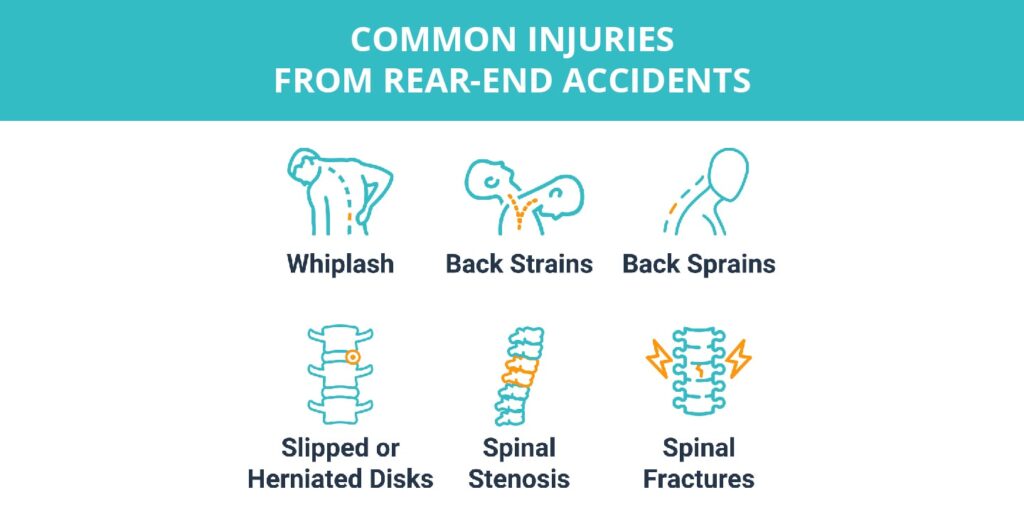
Rear-end crashes occur when one vehicle strikes the back of another. This is the most frequently occurring type of vehicle collision. The most common causes of rear-end accidents include distracted driving (texting, talking on the phone, eating, changing the radio, or distractions from other passengers in the vehicle); following too closely (also known as tailgating); speeding, and reckless driving. If you or a loved one has been injured in a rear-end accident, you may be eligible to file a claim and recover compensation. Getting started with your case is easy. Request a free case evaluation online or call (888) 802-0827.
The typical car accident settlement is worth approximately $37,000. The average rear-end accident settlement amount may be higher or lower depending on the unique circumstances of your case.
Whiplash
Whiplash (also known as a cervical strain or neck strain) is a common response to a rear-end accident and the most common post-accident neck injury. When a vehicle is struck in the rear, a forceful, sudden back-and-forth movement of the neck can occur, resulting in ligament sprains. Whiplash is often considered a minor injury that can resolve quickly with conservative treatment such as medication, injections, heat and ice, physical therapy, or chiropractic treatment. However, in some instances, cervical strains can cause serious muscle and nerve damage, especially if it’s left untreated. Some people may even experience whiplash-associated disorders for many years after an accident.
Back strains
A back strain (also known as a thoracic strain or lumbar strain) is a soft tissue injury to a muscle or tendon. Tendons are tough, fibrous bands of tissue that connect muscles to bones. With a back strain, the muscles and tendons that support the spine are twisted, pulled, or torn. With the sudden back-and-forth movement that can occur after a rear-end accident, back strains are also a common response. Even low-speed impacts can exert enough force on the back to cause a back strain that results in back pain, cramping, and a decreased range of motion. Back strains can often be treated with conservative care such as medication, injections, heat and ice, physical therapy, or chiropractic treatment but can sometimes result in long-term injuries.
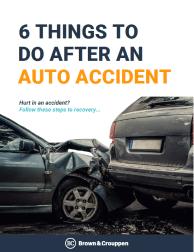

Use our legal checklist to learn what to do after an accident and understand key legal considerations for recovering financial compensation.
Back sprains
A back sprain (also known as a thoracic sprain or lumbar sprain) is very similar to a back strain, but it instead affects the ligaments in your back rather than muscles or tendons. A back sprain occurs when ligaments in the back are stretched or torn from their attachments. Sprains happen most often as a result of falls, sudden twists, or blows to the back. This means the exertion of force on the back from a rear-end collision or a sudden back-and-forth movement could easily result in a back sprain.
Those who have suffered a back sprain in a rear-end collision will likely experience back pain that worsens with movement. Pain from a back sprain can even cause difficulty walking. Back sprains can often be treated with conservative care such as medication, injections, heat and ice, physical therapy, or chiropractic treatment but can sometimes result in long-term injuries.
Slipped or herniated disk
A herniated disk refers to a problem with one of the rubbery cushions, called disks, that sit between the vertebrae that stack to make the spine. A spinal disk has a soft, jellylike center called a nucleus. The nucleus is encased in a tougher, rubbery exterior, known as the annulus. A herniated disk occurs when some of the nucleus pushes out through a tear in the annulus. A herniated disk is sometimes called a slipped disk or a ruptured disk. A herniated disk, which can occur in any part of the spine, most often occurs in the lower back.
While some people may have no symptoms from a herniated disk, and may have even had a herniated disk prior to a rear-end collision, the impact of a rear-end collision can cause herniated disk symptoms. Many people have no symptoms from a herniated disk, but depending on where the herniated disk is, it can result in pain, numbness, or weakness in an arm or a leg. Slipped or herniated disk injuries can also be treated conservatively, and surgery is typically not necessary. However, serious complications and long-term injury can occur if it’s left untreated.
Spinal stenosis
Spinal stenosis occurs when the space inside the backbone is too small. This results in pressure on the spinal cord and the nerves that travel through the spine. Spinal stenosis occurs most often in the lower back and the neck. Some people with spinal stenosis have no symptoms, while others may experience pain, tingling, numbness, and muscle weakness. The most common cause of spinal stenosis is wear-and-tear changes in the spine. Untreated spinal injuries from rear-end collisions can certainly result in spinal stenosis. People who have severe cases of spinal stenosis may need surgery to create more space inside the spine. This can ease the symptoms caused by pressure on the spinal cord or nerves. But surgery can’t cure arthritis, so arthritis pain in the spine may continue.
Spinal fractures
A spinal fracture is a medical term for breaking any vertebrae. A healthcare provider will classify the fracture in the spine based on where it is located and how the vertebrae are broken. They’ll also classify the fracture as stable or unstable, depending on whether the vertebrae are out of their usual alignment. Spinal fractures are one of the more severe injuries associated with rear-end collisions. They’re more likely to stem from a high-speed collision or collision involving a heavy commercial vehicle because of the greater amount of force exerted on the spine. The recovery and treatment for a spinal fracture can vary depending on the type of fracture:
- Burst fracture – Burst fractures happen when the spine is suddenly compressed with a strong force. They can cause the vertebrae to break into many pieces. There is a greater risk of spinal cord injury and spinal instability with a burst fracture.
- Chance fracture – Chance fractures are caused by a strong force pulling the vertebrae away from each other. Instead of the spine getting compressed, Chance fractures happen when something pulls it apart. Many people with Chance fractures get them during car accidents after their seatbelt catches their lower body and their upper body is jerked forward. Always wear your seatbelt with the shoulder harness around the upper half of your body.
- Compression fracture – Compression fractures are small breaks or cracks in the vertebrae. Fractures in the bone cause the spine to weaken and collapse. Over time, these fractures affect posture. The spine curves forward and the person looks “hunched over” (kyphosis). Compression fractures usually happen in the thoracic (middle) part of the spine, especially in the lower thoracic area. Medical providers also call them vertebral compression fractures (VCF).
Most spinal fractures don’t need surgery and may be resolved by wearing a back brace for a few months. However, severe spinal fractures will need to be surgically repaired.
Medical providers will classify spinal fractures as stable or unstable. With a stable fracture, the injury that broke the vertebrae didn’t push or pull them out of their usual place in the spine. Surgery is less likely with a stable fracture. Unstable spinal fractures happen when an injury moves the vertebrae out of their usual alignment. They’re more serious than stable fractures and carry a higher risk of needing surgery. They also carry a higher risk for dangerous complications that can affect your spinal cord.
Injured in a Rear-end Accident? Get Help from Brown & Crouppen Law Firm
If you are involved in a rear-end collision and experiencing pain, it is important to seek medical treatment right away. If a rear-end collision results in injury, minor or severe, it’s best to consult with an experienced lawyer as soon as possible. An experienced lawyer can help you build a strong case from the very beginning. The attorneys at Brown & Crouppen can help you seek financial compensation for injuries, medical bills, property damage, and other damages that may have resulted from the car crash.
Getting started is easy. Request a free case evaluation online or call us at (888) 802-0827. Our rear-end accident attorneys are located in St. Louis, Kansas City, and surrounding areas to serve you. And remember, our accident & injury lawyers work on a contingency-fee basis, meaning there are no upfront costs or legal fees – we only get paid if you win.

